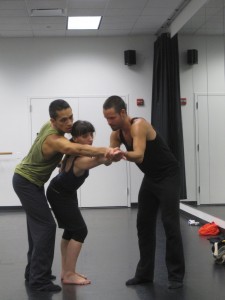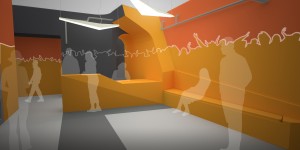
Giordano dancers Martin Ortiz & Maeghan McHale work with choreographer Alexander Ekman. Photo by Joel Solari.
A whimsically humorous contemporary duet by Swedish phenom choreographer Alexander Ekman will mark Giordano Dance Chicago‘s (GDC) debut performance at the Chicago Dancing Festival (CDF) this August. A small group was given a preview yesterday afternoon at Columbia College’s studios on South Wabash. Ekman, 28, danced with the Royal Swedish Ballet, Nederlands Dans Theater (NDT), Cullberg Ballet and Ballet du Rhin before embarking on his choreographic career, which started in 2006 with a piece created for NDT II. Since then, he has made new works for companies around the world. His work, Two Become Three, was originally created last year on dancers at Julliard where CDF co-founder Lar Lubovitch saw the piece and commissioned it for the opening night of this year’s festival.
Ekman has been in town since Monday and set the piece on GDC dancers Maeghan McHale and Martin Ortiz Tapia in about three days. Ekman recorded a voice over that plays on top of the score providing an audible inner monologue of the characters on stage. A “surprise” prop at the end of the piece provides another layer of humor to the tongue-in-cheek piece that garnered laughter from the viewers at rehearsal. The piece is lighthearted and fun, but the dancing is anything but simple. These two seasoned dancers take the physical and theatrical demands in stride. An obvious respect and rapport grew out of the intense few days in the studio and the result will delight the audience at Chicago Dancing on Monday, August 20 at the Harris Theater for Music and Dance.
Debuting at CDF12 isn’t the only exciting things happening for GDC. Kicking off their 50th anniversary season, the company changed its name (notice the “Jazz” is gone), has a brand new website and logo, as well as new administrative offices (1509 S Michigan Ave, 2nd floor) and is a resident company at the new American Rhythm Center* (ARC) which will open new studio space later this month. If good things come in three’s, they’ve overshot by a few and I see only more good things in the future for GDC.
Chicago Dancing Festival presents Chicago Dancing at the Harris Theater, 205 E. Randolph, Monday, August 20 at 7 pm. Tickets will be released Tuesday, July 17 at noon. For more information, visit www.chicagodancingfestival.com.
*More information on ARC here.

